Partida Rol por web
Justice in Sabbath
Aces&Eights-Tutorials
- Portada
- Announcements / Latest News / Questions
- Saloon [Off-topic]
- 0. [Pre-Production] Cattle Thieves
- 0. [Pre-Production] The Mormon Businessman
- 0. [Prologue] Welcome to the West
- 1. [ACT1-Scene1] Saddle Up
- 2. [ACT1-Scene2] The Outlaws
- 3. [ACT1-Scene3] San Acoma
- 4. [ACT1-Sc4] The Cattle Drive
- 5. [ACT1-Sc5] Guns for Hire!
- 6. [ACT1-Sc6] Fun Night Out in Bannock
- 7. [AC1-Sc7] The Hunter
- 8. [ACT1-Sc8] Ride into Sabbath
- 9. [Act1-Sc9] A Bed too Big
- 10. [ACT1-END] End of Act I
- 11. [ACT2-Sc11] He Carried the Law
- 12. [ACT2-Sc12] First Meeting at the Bronson Ranch
- 13. [ACT2-Sc13] Day for Choosing
- 14. [ACT2-Sc14] The World Turning Beneath Your Feet
- 15. [ACT 2-Sc15] Laura´s Room
- 16. [ACT2-Sc16] Who´s Got the Edge
- 17. [ACT2-Sc17] Business in Town
- 18. [ACT2-Sc18] El Alacran
- 19. [ACT2-Sc19] The Predators
- 20. [ACT2-Sc20] Old Fort Gunfight
- 21. [ACT2-Sc21] Vigilante Justice
- 22. [ACT2-Sc22] Trinity
- 23. [ACT2-Sc23] At the Price Farm
- 24. [ACT2-Sc24] Hour of the Gun
- 25. [ACT2-Sc25] When the Dead Are Buried
- 26. [ACT2-Sc26] High Stakes
- 27. [ACT2-END] End of Act II
- 28. [ACT3-Sc28] Resolution
- 29. [ACT3-Sc29] Epilogue
- [Additional Content] Guide to the West
- Boothill
- Aces&Eights-Tutorials
- The Poker Room
- Shooting Range
- Goods & Services
- Err ... What?
- Casting
- Musical Score
- Behind the Scenes (VIP)
- Director´s Corner
SYSTEM OVERVIEW AND CHARACTER CREATION
“Aces and Eights” (A&8) is a fairly simple system, but with some peculiar characteristics. I have written a few tutorials to explain the basics. First thing to know of each character is their Speed and Accuracy, which are calculated as a result of other abilities. There are no levels and no professions in Aces & Eights. Characters advance through accomplishing goals, and can choose different life paths (eg. you start off as a cowboy, then become a shopkeeper, etc).
Most actions are resolved by rolling dice, sometimes the target is less sometimes it is more. On some rolls, a natural 1 is a fumble and there is also a chance of “Penetration” if the highest score is rolled, you repeat the roll and add the result (-1).
Ability Checks (if required) are done on a 1d20 and the objective is to roll less than your Ability.
Then we have the Skills. Each Skill has a Skill Mastery level, where 100% is unskilled. Skill checks are rolled on 1D100, and the objective is to roll greater or equal.
| 100% | Unskilled (only universal skills can be used at this level) |
| 99-75% | Novice |
| 74-50% | Average |
| 49-25% | Advanced |
| 24-13% | Expert |
| 12-0% | Master |
Many skills are classed as "Universal", and a character can roll with the ability bonus without actually having purchased the skill.
The SKILL CHECK MODIFIERS
| DIFFICULTY | MODIFIER TO ROLL |
| Trivial | +90% |
| Easy | +80% |
| Average | +40% |
| Difficult | +0% |
| Very Difficult | -10% |
Next we will go through the basic steps for Character Generation, and then a few words about Reputation and Fame.
CHARACTER CREATION
There are some very handy Excel sheets available which I use to create the characters and then upload a screenshot of the sheet.
http://www.kenzerco.com/forums/showthread.php?5276...
(from the official A&8´s forums)
STEP 1: Building Points
So, during the Character creation process, each character receives 75 Building Points (BP) that are spent to improve Abilities or to get new skills. As there are no professions as such, we move directly to the Abilities.
STEP 2: Abilities
Each character has seven basic Abilities:
Strength (Str): measures muscle power, determines the weight a character is able to lift and carry. Damage modifier for close-quarter combat and weapons used in brawling.
Intelligence (Int): memory, reasoning and ability to think through. Accuracy modifier (combines with Dexterity for Base Accuracy), BP bonus (extra skills that are Intelligence-based), Skill learning modifier
Wisdom (Wis): common sense and empathic ability. Speed modifiers (combines with Dexterity for Base Speed), BP bonus for Wisdom-bases skills, Skill learning modifier
Dexterity (Dex): agility, coordination and deftness, reflexes, speed and accuracy. Speed modifier (combined with Wisdom), Accuracy Modifier (combined with Intelligence), To-hit modifier (adjusts the chance to hit a target at close quarters).
Constitution (Con): health, hardiness, stoutness. Hit Point modifier (the base hit points are 20+1D4, modified by Constitution).
Looks (Lks): physical attractiveness and appearance. First impressions. Looks is not Charisma, but it can affect Charisma on a permanent basis. Charisma Modifier, Starting Reputation Modifier, Starting Fame Modifier
Charisma (Cha): charm, wit, personal influence and leadership ability. Affects Reputation and Fame. BP bonus for Charisma-related skills, Skill Learning Modifier, Max. number of Compatriots (number of non-player characters that can potentially serve under the character), starting Reputation Modifier.
The abilities are randomly rolled 3D6 plus 1D100 for the fractional ability of each. The fractional ability determines how close the character is to reaching the next ability score (Strength 13/45 means that the character must increase his fractional ability by 65 points to gain a Strength of 14/10). If you are unhappy with your rolls, you can adjust them using BP. You can also increase one Ability by decreasing another (this tutorial aims to give an overview of the process, we will create each character in detail and can go over the specifics then)
STEP 3: Background
Here we choose a Nationality, roll Priors and Particulars (different background options), including starting age, social class, and so on. This has very little direct effect on game play, but helps to flesh out the character.
STEP 4: Reputation and Bonus BPs
The final Ability scores are calculated, as well as starting Reputation and bonus BPs for high Ability scores. Reputation is quite important in A&8s, more on that on the specific Tutorial: Reputation and Fame
STEP 5: Quirks and Flaws
Quirks and Flaws represent aspects that make the character unique. Quirks are usually mental in nature, while Flaws are physical. You get extra BPs for them, and they can be either random or chosen.
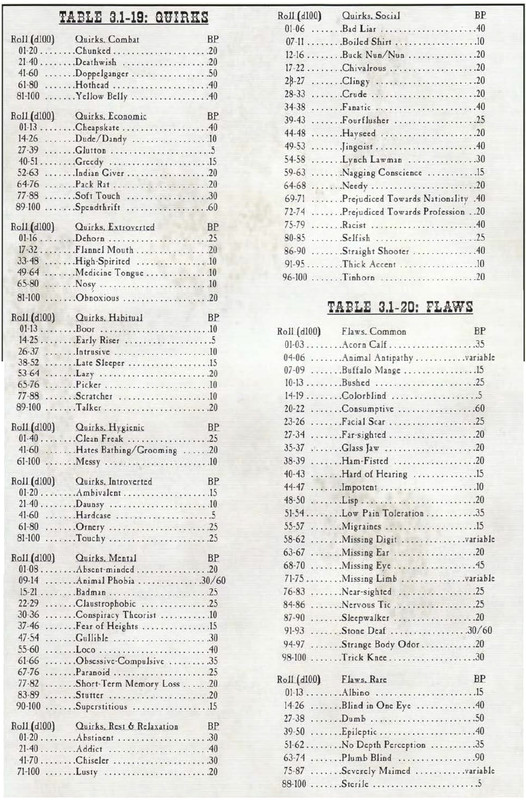
STEP 6: Skills and Talents
So, after the Abilities have been rolled and modified, the extra BPs counted (from high Ability scores and Flaws), it is time to purchase Skills and Talents. This is done using BPs plus some extra points gained from high Charisma, Intelligence and/or Wisdom. The BP cost on the list is modified by Ability bonuses...

LIST OF TALENTS (and cost in BPs)
Advanced Sighting........70
Astute Observation.......50
Blind-shooting..............45
Courage......................10
Crack Shot...................50
Damage Bonus..............75
Dead Eye.....................50
Deadly Shot.................50
Dodge.........................25
Endurance...................15
Fan Firing.....................35
Fast Healer..................10
Forgettable Face...........25
Greased Lightning..........20
Great Ambidexterity.......25
Grit.............................50
Guardian Angel..............30
Hearty.........................50
Hip Shooter...................25
Hit Point Bonus..............20
Hold Your Liquor.............10
Improved Arc of Fire.......15
Inheritance...................10+
Jack Rabbit Speed..........20
Kentucky Windage..........45
Mounted Marksmanship....10
Perceive Tendency..........20
Quick Aim......................10
Quick Thinking................10
Rapid Reload...................20
Reputation Bonus............35
Resist Disease/Infection...20
Shot on the Run.............50
Sprinter........................30
Tough as Nails...............25
Veteran Gunfighter..........20
Weapon Bonus...............50
STEP 7: Hit Points, Accuracy and Speed
Hit points are calculated rolling 1D4+20 and adding some modifiers.
Base Accuracy and Speed have different modifiers, and are especially important in Gunfights.
STEP 8: Equipment
Finally, players start with some money to equip their character.
TUTORIAL: REPUTATION & FAME
REPUTATION
Reputation (Rep) defines how the character measures up to society's ideals of courage, integrity and inner strength. Can his partner count on him in a scrape? Is his word his bond or is he a liar? Will he let someone question his honor without a fight? Is he a cheat, backshooter or coward? Reputation is important because it influences the way others treat your character and can affect your luck. Reputation fluctuates depending on the character's actions and behavior. Reputation is not a judgment of good and evil. Individuals of high Reputation are not necessarily good and those with low Reputation arc not necessarily evil.
Reputation is more a measure of the deeds accomplished by the individual and sometimes his family, as well as those with whom he associates himself (his partners or gang). It is an indication of such things as success in gunfights or politics, loyalty, talent and success.
When a character loses Reputation, he loses honor. Reputation is essential to the character. People can sense how much Reputation a PC has just by standing in his presence.
Starting Reputation is the average of the seven Abilities plus the modifier from Looks and Charisma.
CATEGORIES OF REPUTATION
Disreputable (0-5): Disreputable characters are looked upon as the dregs of society. They suffer harassment and ridicule. Characters in the Disreputable category suffer a -1 penalty to all die rolls.
Low Reputation (6-20): often distrusted, mistreated or ignored. Many characters begin in this category, and they haven´t necessarily done anything to deserve any unjust treatment.
Average Reputation (21-70): Mostly ordinary citizens who make an honest living.
Great Reputation (71-100): Characters that have proven repeatedly that they have what it takes to defend their honor and act with integrity. Others know that someone with a great Reputation is not to be trifled with. They receive a +1 to all die rolls and gain an additional 1 BP for every 10 BP earned. They also receive a “mulligan” (one free re-roll per game session).
Legendary Reputation (101+): he inspires stories, legends and gossip. +1 to all die rolls, 10% extra on any BP earned, and two “mulligans” per session. On the other hand, Legendary characters are more likely targeted by adversaries.
REPUTATION SCORE AND REPUTATION POINTS
A character is first assigned a number of Reputation points identical to his Reputation score. If a character´s reputation score moves up or down, the Reputation Points are adjusted by the same amount. A character may spend Reputation Points without adjusting his Reputation Score in order to gain advantages in the game. 10 Reputation Points allows for 1 re-roll of his combat rolls, ability checks, or skill checks, or also to make other re-roll a roll that directly affects this person. A re-roll can be re-rolled multiple times.
INDIVIDUAL&GROUP REPUTATION
During a typical game session (Scene), characters earn or loose Reputation depending on their action (see below). Also, whenever two or more characters partner up, they should calculate their group reputation (an average of the Reputation of those characters comprising the group). After a gaming session, the individual Reputation points are distributed. Each player must then adjust his character´s individual Reputation one point closer to the group Reputation score. This means those characters with low Reputation will benefit by being part of the group and having their Reputation raised.
NOTORIETY
When a character loses Reputation such that his score becomes negative, it is no longer called Reputation but rather Notoriety. Notoriety has similar categories as Reputation but offers none of the same benefits. A character can still perform acts that increase his Reputation score, but he gains no corresponding Reputation Points until his Reputation becomes positive again. In gunfights, the absolute value of their Notoriety score is used to confirm reaction.
OATHS
A man´s word is his honor, and breaking an oath has dire consequences. When a character swears an oath, he is literally swearing by his Reputation. If he breaks the oath (intentionally or otherwise), the character loses respect.
Note that keeping or making good on oath has no extra benefit. A person is expected to keep his word.
FAME
Fame defines how well known the character is. Does everyone in town know him? When he rides into a new community does word spread of his arrival? Fame begins slow, and increases throughout a character´s career.
Note that fame is not an indication of how well respected or liked a character is, or whether he is a good or bad person. It simply indicates how well known the character is.
Starting Fame is 0 plus any modifiers from Looks or Priors&Particulars
Group Fame works in the same way as Group Reputation.
CATEGORIES OF FAME
Little Known (0-10): Only a few people know you exist.
Local (11-20): Seems like everyone in town knows who you are and your deeds.
Minor Celebrity (21-70): Even the wranglers in the next territory know about you. When a character´s Fame reaches 50 for the first time, his name begins appearing in popular songs and stories as a minor or local hero (or villain). In addition, there is a 10% chance per week that a notorious foe starts boasting of his ability to whip the character. For every 50 points of Fame a character has, others suffer -1 penalty to Accuracy and +1 penalty to Speed when facing him.
Major Celebrity (71-100): You´re extremely well known. For example, the person working on the docks in New York City has heard of you.
Famous (101-200): You and your deeds are occasionally heard of even in lands across the ocean.
Epic (201+): considered a great hero, suitable material for epic songs and the like.
GAINING AND LOSING REPUTATION & FAME
The Reputation (and Fame and BPs) are assigned after each Scene.
One´s fame may not reflect reality. Also, Fame disappears slowly. It decreases at a rate of 1 point per month. Fortunately, this loss of Fame can go no lower than 20% of the highest Fame the character ever obtained.
The following tables give an indication of Reputation and Fame adjustments.
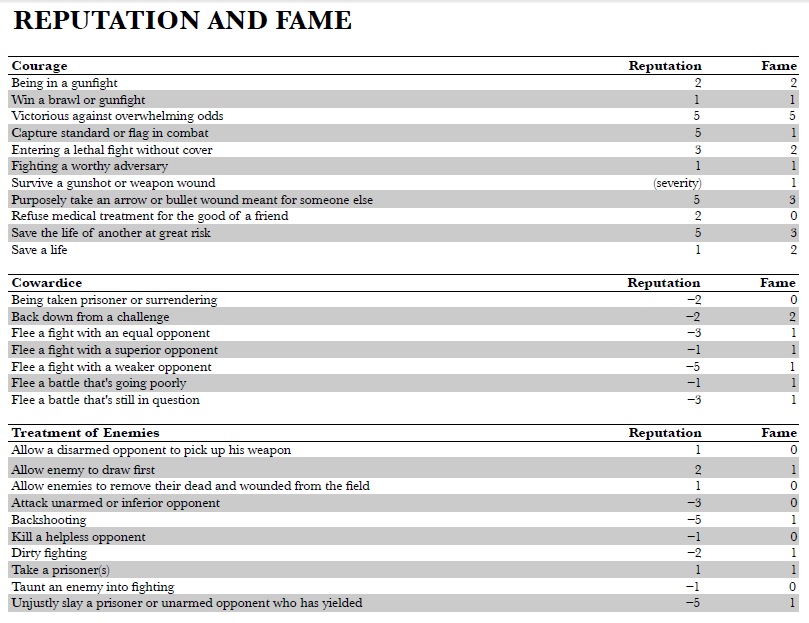
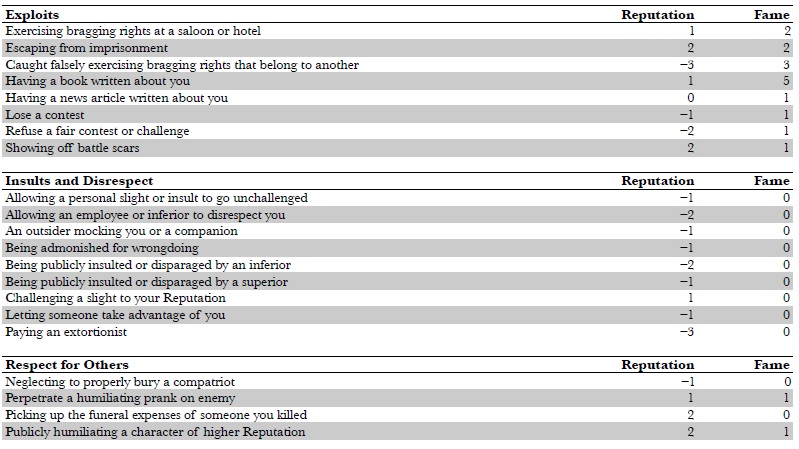
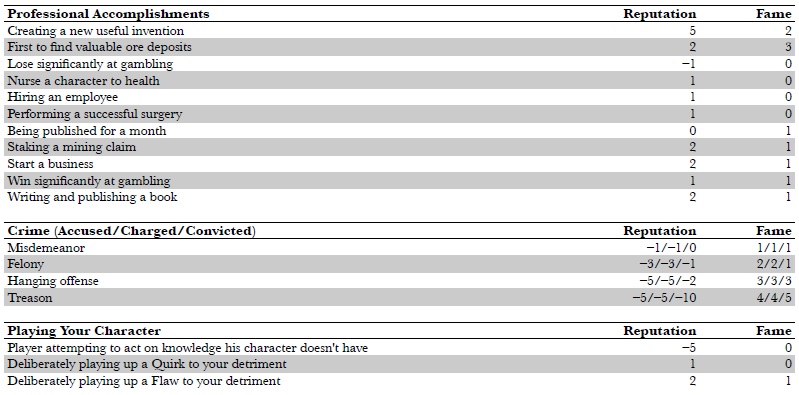
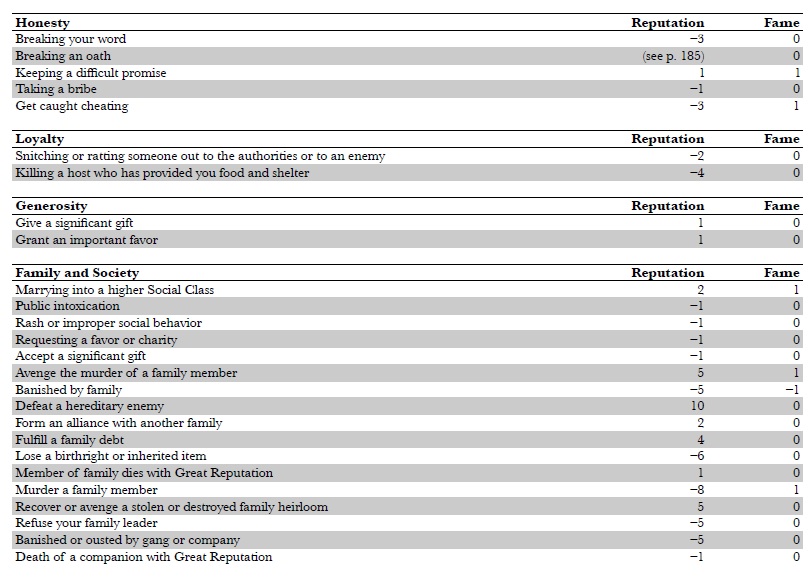
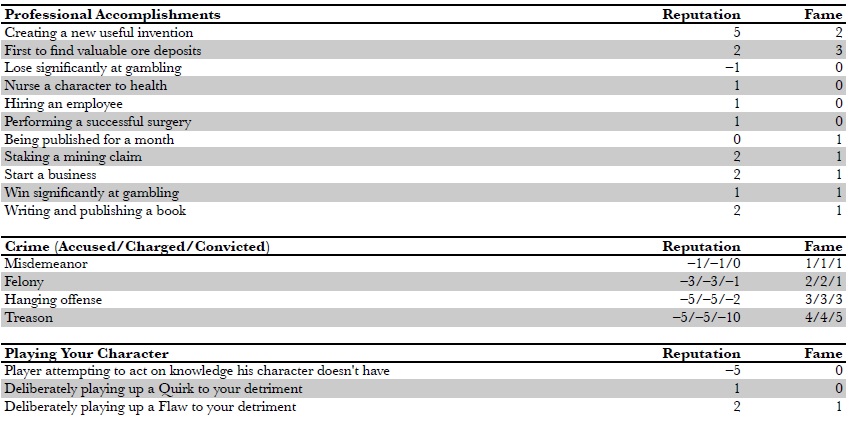
REPUTATION & FAME EFFECTS ON SCRAPES
Depending on the Fame and Reputation of a character, his opponent can cause nervousness and panic before a gun is even drawn. This has no effect if the character does not know who the famous opponent is. Also characters of low esteem tend to get rattled and lose their cool when the going gets tough. On the other hand, those deserving of respect are great individuals and rise to the occasion, however difficult.
This is to reflect how man gets caught in his own doing. Sometimes, there is simply no option when faced with own mortality.
Summing it up, characters of unexceptional Reputation suffer penalties in when hurt and when facing famous opponents.
Disreputable (0-5): Must leave a fight immediately after a graze or non-brawling wound. +2 Speed/–2 Accuracy for each 25 Fame below opponent.
Low Reputation (6-20): Must seek cover immediately after losing 25% of Hit Points; must flee if shot at again. +2 Speed and –2 Accuracy for each 25 Fame below opponent.
Average Reputation (21-70): Must seek cover immediately after losing 50% of Hit Points; must flee if injured again. +1 Speed and –1 Accuracy for each 25 Fame below opponent.
Great Reputation (71-100): May always choose whether or not to seek cover or remain in a fight.
Legendary (101+): May never run from a fight.
TUTORIAL: GUNFIGHTS
The fundamental premise of the Aces&Eights gunfight system is that a shooter always aims for a specific location or target. The worse the aim, the further from his mark the shot flies. To determine the shot location, the system uses Target Silhouettes and a Shot Clock template.
The time in a gunfight is measured in tenths of seconds. Each tenth of a second is referred to as a “Count”. There are no “turns” as such. Each action is declared and after a certain amount of time (Counts), the action is completed.
Initiative and Speed
To find out who goes first, an Initiative roll is made. That is, 1D10 plus modifiers such as speed, previous gunfight experience, Fame, weapon model, etc.
Gunfight Procedure
1. Declare an Action: the order in which actions are declared is based on Wisdom, from the lowest to the highest (unless someone blurts out what they want to do)
2. Roll Initiative (d10)
3. Calculate Starting Initiative (Base Speed+Initiative)
4. Add Action Counts to determine when first action occurs
5. Take action when Count Up reaches sum of step #4 above
Count Up is a simple slow count up from one until the Count Up reaches a number where a player has an action declared…
SHOOTING PROCEDURE (modified for "Web Roleplaying)
1. Declare general specific target location
2. Add all Accuracy modifiers
3. Take the shot (roll d20 and add all modifiers). <14 is a miss, 25+ is an exact hit.
4. If the result is between 14 and 25, place the center of the Shot Clock over the intended target location on the Target Silhouette
5. Draw a card to determine exact shot location (1d4+1d12) (if necessary).
1d4 => 1=Hearts, 2=Clubs, 3=Spades,4=Diamonds
1d12 => 1=Ace,2,3,4,5,6,7,8... 9 is either 9 or 10 (reroll 1d2), 10=J, 11=Q,12=K
6. Roll damage (if necessary). Penetration applies.
AIMING
After the gun is drawn out, following actions happen:
Aiming (bringing a fire arm to bear/aim) => 4 Counts. This is the normal procedure, basically it means to aim. You can choose to Hipshoot (see below) or reduce this time using Fanfire.
Additional aiming (time added to the 4 Count above)
Steady Hand: bringing a second hand to hold steady a pistol in the other hand. Applies only to pistols, and the second hand has to be free/empty. 2 Counts, +2 Accuracy
Fire Deliberately: deliberate shooters take their time to get a better accuracy. Pistols: 4 Counts, +2 Accuracy. Rifle: 8 Counts, +4 Accuracy
Taking Careful Aim: this involves sighting a target for 1-2 seconds while maintaining relaxed or controlled breathing. Cannot be combines with Firing Deliberately. A man Firing Deliberately can choose not to shoot and continue aiming to gain the Taking Careful Aim bonus instead. Pistols: 10 Counts, +3 Accuracy. Rifles: 20 Counts, +6 Accuracy (NOTE: there is a typo in the reference sheet, it says *+3 Accuracy but it is +6 for Rifle).
Related actions:
Hipshooting: Basically firing without aiming. Pistols: 0 Counts, -4 Accuracy. Rifle: 6 Counts, -4 Accuracy.
Fanfire: Most shooters pull the hammer back with the thumb of the hand holding the weapon. In order to get a Speed advantage, some gunslingers prefer to use their off hand in a palm down fanning motion to repeatedly pull back the hammer (possible while holding the trigger down). This causes highly inaccurate, though fast, firing. Pistols only. -2 Speed bonus, -6 Accuracy. Cannot be combined with aiming to get extra bonus, but the 4 initial 4 counts apply (reduced to 2 because of -2). So the first fanfired shot is not better than hipshooting, but additional shots follow very rapidly.
SHOOTING ACTIONS (basic shooting actions explained).
Firing a Cocked Weapon: Firing an already-cocked weapon is the simple act of pulling the trigger; it takes but a tenth or a second (1 Count). Most other activities already incorporate this modifier, and it should not be added as an additional time delay to other actions. It is listed here solely for the case where a character has a cocked weapon trained on another character.
Cocking and Firing a Pointed Weapon: It only takes 3 Counts to pull back the hammer and shoot at someone if your gun is pointed in their direction and has not been fired for at least one second.
Cocking and Firing a Pistol (2nd+ shots): After the first shot, it takes a half a second (5 Count) to cock and fire a pistol. Furthermore, a pistol already brought to bear or aimed remains in that position while being cocked and fired.
Cocking and Firing a Rifle (2nd+ .shots): After the first shot, it takes 6 Counts to work the lever and fire a rifle. Hurried shooters can opt to fire the second shot unaimed; this action takes only 6 Counts but is obviously less accurate (see Hipshooting, below). Careful shooters will opt to re-aim the rifle (a 10 total Count).
Cocking and Firing a 2nd Shotgun Barrel: After the first shot, it takes 14 Counts to steady the gun, cock the hammer and fire (11 if already cocked) Hurried shooters can opt to fire the second shot without aiming; this action takes only 10 Counts (7 if already cocked) but is obviously less accurate (see Hipshooting,below).
Bringing a Firearm to Bear/Aiming: (4 Counts).This is the time it takes to bring a drawn weapon up to an aimed position or aim a pointed weapon. You need to take this action or else you'll be shooting less accurately.
Drawing a Weapon/Pistol/Knife/Hand Axe: The act of pulling the pistol from a holster, knife from a sheath or hand axe from a belt loop takes around 5 Counts.
Drawing a Weapon: Rifle/Spear / Lance/ Axe: The act of pulling the rifle or saber from a scabbard, or hefting a spear, lance or axe takes about a 10 Count.
Drawing Two Weapons at once: Drawing two weapons at once causes a slight decrease in draw speed to the tune of an extra 5 Counts (i.e., each gun takes 10 counts to draw).
Drawing with Off Hand: Drawing with the off hand is slower than the primary hand by 5 counts. This is not a cumulative penalty if TWO weapons are drawn at once (i.e" each gun takes 10 Counts to draw).
Drawing Without Holster: Drawing from a boot, belt, pocket, etc., affords an opportunity for the weapon to get hung up on clothing or other accouterments. Because the delay could vary from draw to draw, drawing without a holster causes a d4 Count penalty.
Fanfiring: Typically, a shooter uses the thumb on the hand holding the gun to pull back the hammer. In contrast, while fanning the hammer or fanfiring the shooter uses the hand not holding the gun, held palm down, to pull back the hammer in a fanning motion. Fanning allows for rapid shooting and affords a -2 Speed bonus. Note, however, that it provides a substantial Accuracy penalty as well. Fanned guns cannot be aimed, carefully or otherwise.
Loading: Pistol (per cartridge): It takes 10 Count to load a cartridge into a revolver. Cap and ball revolvers require far more time to reload and are not considered in the Scrapes section but see Loading: Replacing a Cylinder,
Loading: Replacing a Cylinder: It takes 10 seconds or 100 Count to remove and replace cylinder on a cap and ball revolver or revolving rifle.
Loading: Rifle: It takes a 10 Count to load a cartridge into a rifle.
Loading: Shotgun (one shell): it takes a 25 Count to load a shell into a shotgun. This involves breaking open the shotgun and pulling out a spent shell. If no shells need to be removed, the time drops to 23 Counts.
Loading: Shotgun (two shells): It takes 30 Count to load two shells into a shotgun. This involves breaking open the shotgun and pulling out the spent shells. If no shells need to be removed. the time drops to 28 Counts.
Loading (From Shell Loop): While shell and cartridge loops are handy for holding rounds, it takes a mite longer to remove the cartridge or shell from the loop than to simply grab the round from a coat or vest pocket. The penalty is equal to a d4 per round.
Reference tables: Movement action &modifiers and Shooting modifiers
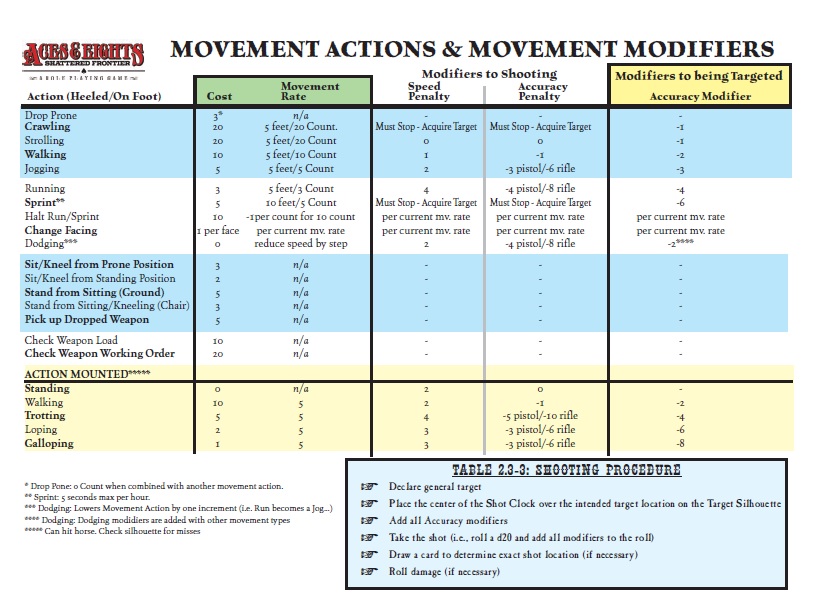
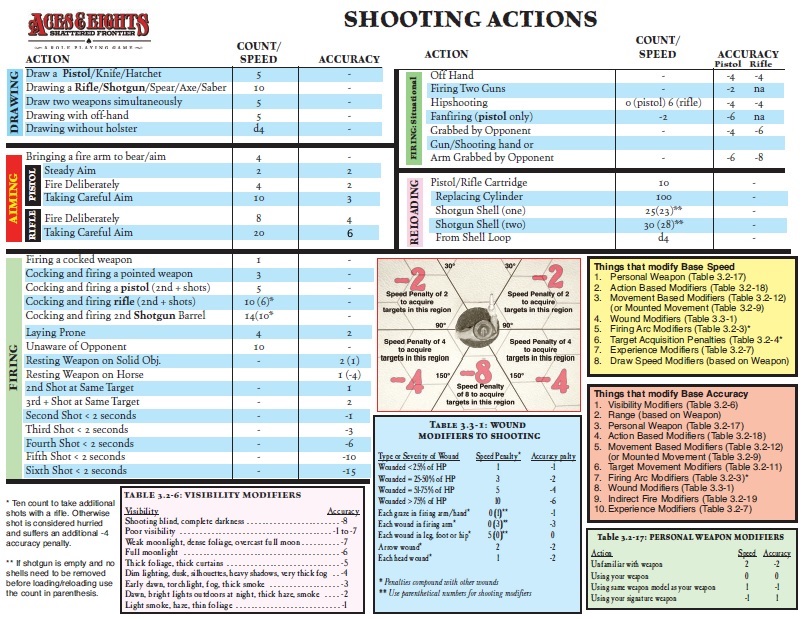
Notas de juego
For a detailed example of a gunfight, please visit the "Shooting Range" scene
BRAWLING
In Wild West stories, we often see cowboys fighting it out with their fists in a saloon. If you enjoy a good barroom brawl, these rules should cover it. There will also be an example fight in the appropriate section.
SETUP
Each character begins with a set number of poker chips that represent that character´s ability to deal and withstand damage and hit other.
Red Chips (Damage) => You receive twice your Strength Score in chips. Each red chip bet gives +1 points of damage
Blue Chips (Agility) => You receive a total number of blue chips equal to the total of your Intelligence and Dexterity. Blue chips determine who swings first. Each blue chip bet gives a +1 “To-hit”.
White Chips (Endurance) => represent your staying power in a fist fight. You get a number equal to the sum of your Wisdom and Constitution scores. White chips reduce any damage suffered from opponents by 2 points per white chip bet.
For shorter brawls, all starting chips are halved
BETTING
Each round of brawling is structured somewhat like a poker game. Each combatant decides how many (if any) of his chips he wishes to use by tossing them into the pot.
Ante: Every player must toss in one white “Endurance” chip to participate, this does not count for Endurance but do count for the pot.
Each player utilizes his chosen number of red, blue and white chips by “betting” and tossing them into the pot.
Each color is handled in turn and each round goes from the lowest to the highest Wisdom.
The maximum chips that may be bet by any character in any given round of brawling is as follows (rounded down):
Red (Damage): ½ Strength score
Blue (Agility): ½ Dexterity score
White (Endurance): ½ Constitution score
BRAWLING
Players take their turns in order of the number of Agility (blue) chips bet. Highest goes first, ties are broken by Dexterity).
To hit another character, the player picks up any adjacent target, rolls a d20 and adds a +1 bonus for each Agility (blue) chip bet. The defender rolls a d20 and adds his Accuracy/Hit Probability modifier granted by his Dexterity score. If the attacker´s roll exceeds the defender´s roll, the attack succeeds.
The injured player must remove the damage total in chips from his three chip stacks in any combination he chooses. Damage dealt by a successful punch is one point plus the number of Damage chips (red) bet by the attacking player. However, if the defender bet any white chips, the damage is reduced by two points for each one Endurance chip (white). If the defending character is damaged, he must remove a number of his own chips (not already in the pot) equal to the damage suffered. No hit points are lost, just chips.
A natural “1” on the attacker´s roll indicates a very poor miss. The attacker suffers a Mishap and the defender may make a free, immediate counter-attack that does not count as his attack. A natural “1” on the defender´s roll gives the attacker an immediate free attack.
A natural roll of “20” for the attacker does double Damage chips and the extra Damage chips ignore any Endurance chips played by the defender. A natural roll of “20” by the defender doubles the value of the Endurance (white) chips played.
After any round of fighting, a character with zero Damage chips is too weak to injure anyone beyond one point, any character with zero Agility chips is too fatigued to throw a really accurate punch and thus can´t get a bonus to-hit, and any character with zero Endurance is winded and must spend one round resting or spend one each of Damage and Agility chips to gain an Endurance chip for ante.
If at any time, a character´s chips are down to zero in all three categories, he´s knocked and/or passed out. Damage beyond the final chip is removed from the character´s hit point total as actual damage, and a character without chips can be beaten to death.
THE RAKE
The highest natural attack roll (not modified by chips) each round wins that round´s pot, less the rake (see below). These chips are then added to that character´s chips and he can use them in future brawling rounds.
A percentage of each typo of chip from each pot is removed as follows:
One of each type chip for every 1-10 chips bet or fraction thereof, for every four brawlers that rolled dice or otherwise contributed to the pot. For example, if the pot consisted of 16 Damage, 21 Agility and 9 Endurance chips, and there were 2-4 brawlers, it would be -2 Damage chips, -3 Agility chips and -1 Endurance chip. If there were 5-8 brawlers, double the chips would be removed, and so on.
In the event of a tie, the chips remain in the pot and the winner of the following round wins both pots.
TIME
Each round of brawling is 10 seconds. Each round of rest earns back three chips of the resting character´s choice that are given at the start of the next round.
STUNNING
Any round in which a character suffers damage to half of his remaining Endurance chips, he is partially stunned for the next round. This means he can bet a maximum of ½ of the chips he could normally bet.
MOVING AND SPECIAL ACTIONS
If a player wants to spend some extra chips on his turn, he can declare a special action. Making a special action is the only time you get to spend more chips than you are normally allowed, since their effects are different. These chips are taken out of the game – they do not go into the “pot” with the others. You can only perform one special action per attack, and the special action is only successful if your attack hits.
Moving: Moving is any special action that doesn´t directly affect another character, such as moving, jumping behind the bar, picking up a chair, or grabbing a whiskey bottle. These actions all cost one blue chip.
Using a Weapon: Actions that directly affect another character cost one of each type of chip. This includes using a weapon or a makeshift weapon. Damage delivered by hitting a character with a weapon is rolled per the weapon and modified by both Strength modifiers (like a normal hit) and Damage chips. The damage total without Damage chips (weapon damage+Strength bonus) is removed from the defender´s hit point total, and the total damage is removed from the character´s chips. Standard Weapon damage is used. Chairs do 1d4 for standard chairs, or 1d6 for heavy chairs. Bottles do 1d3 if empty, 1d4 if half or more full.
Counter Action: it is done by using two chips of each color when another adjacent character tries to perform a Special Action. At that point, the character trying to do the Special Action may add as many blue (Agility) chips to his Special Action as desired. Then, the character playing the Counter Action may bet as many blue chips as he desires. If the Counter Action has more blue chips than the Special Action, the Special Action may choose to add more blue chips and so on until one player is too cowardly to up the stakes any further. Finally, the players each roll a d20 and add +1 per blue chip. If the Special Action Player´s total exceeds the Counter Action Player total, the Special Action may proceed. If the Counter Action player´s total equals or exceeds the Special Action player´s total, the Special Action fails.
Body Blow: a punch to the other guy´s ribs, to his gut, to the center of his body. Costs an extra two red chips, but if the hit is successful, in addition to the normal damage, the opponent also loses one white chip from his stack of unused chips.
Break Away: breaking away from a grab costs two red and two blue chips, and breaking away from a hold costs either four red chips or four blue chips.
Cross: powerful straight punch, it costs a blue and a white but adds two red chips to the attack.
Grab: for example with the left hand to keep him avoiding punches from the right. It costs two red chips, but the opponent can´t play more than one white chip (excluding ante of course) at a time until he breaks free.
Head Butt: slamming your head into the other guy´s face costs one of each chip, but if successful, reduces the opponent´s next attack (in the same round or the next one depending on whether he attacked this round already) by two blue chips and one white chip.
Haymaker: a wild hook from the back fist. Costs two blue and two white but adds three red chips to the attack.
Hold: grabbing someone and holding while somebody else hits him. It costs two red and two blue chips. Once held, the opponent cannot play any white chips (except for ante) or do much other than try to break the hold.
Hook: pivoting around and hitting on the side of the face, costs one white chip but adds one extra red chip to the attack.
Jab: quick, straight punch can be pretty useful, costs two red but adds two blue chips.
Kick: no fancy judo maneuver, but kicking someone when he´s down on the ground. Costs three blue and three white chips, but ads extra four red chips to the attack.
Kidney Punch: a punch to the lower back, aiming for the other guy´s kidneys. Costs three blue chips and one white chip, but the opponent cannot reduce damage from this attack with white chips.
Low Blow: a hit between the other guy´s legs. It costs two blue chips, but if successful, the opponent can´t get more than one blue chip on his next action. Using a Low Blow also reduces that character´s Reputation by one.
Push: a push or shove costs two red and one white, but the other guy ends up down on the ground and has to spend one of each color next round to get back on his feet. He cannot stand back up and attack in the same round.
Rabbit Punch: chopping blow to the back of the neck, it costs four blue chips but if successful, increases the attack by three red chips.
Spur: if you are standing above some poor fellow you really don´t like, you can cut him with your spur. It costs three blue chips but does an extra two points of weapon damage.
Trip: sticking out your foot at the right time costs two blue chips, but the other guy can´t bet any more than one blue and one white on his next action (he can bet as many reds as normal).
Uppercut: curling your arm and elbow down by your side, and bringing the fist up hard and fast up into the other guy´s chin… It costs one of each chip, but the attack stuns the opponent if your damage equals ¼ of his remaining Endurance (white) chips (normally it requires ½ or more).
WOUNDS & HEALING
Severity level: the severity level of the wound equals the HP loss it caused. So a wound that caused 7 HP damage has a Severity Level of 7.
Any special effects of the wound (such as profuse bleeding) are unknown to the character unless takes one second per severity level of the wound to examine it).
Penetration rules are not used for healing or damage caused by bleeding etc. (*)
HEALING TIME (basic wounds)
Any wound a character takes will heal in a number of days equal to the damage the wound caused, and the character then recovers 1 HP, and the wound drops to the next lowest severity. A 4 hp wound will take 4 days of rest to become a 3 hp wound, and the other effects are reduced in the same way. So a total recovery time for a 4 hp wound would be 4+3+2+1=10 days.
Note that the wounds heal simultaneously, so it is important to keep track of each individual wound.
Certain wounds have an additional effect of severe bleeding, internal bleeding or internal hemorrhaging. The additional bleeding damage is counted as a separate and distinct wound from the injury that caused the bleeding to occur.
CON bonus and penalties: characters with a very high or low constitution score get their healing time adjusted (below 8 or above 13).
NURSING
Proper nursing is essential to ensure that any injuries heal in the quickest time possible. One day is added to the total for each hit point recovered if nursing is foregone.
INFECTIONS
Infections are frequent side effect of bullet wounds and particularly common to injuries caused by edged weapons such as knives, axes and arrows.
For any serious wound sustained, a character must make a CON check (known only to the GM) to ascertain if the wound has the potential to become infected.
Wound severity threshold:
| LOCATION | SEVERITY THRESHOLD |
| Head | 6 |
|
Foot, Ankle, Lower leg, Knee, Thigh, Chest, Arm, Forearm, Hand, Neck, Face |
5 |
|
Hip/Buttock, Abdomen, Back, Shoulder |
4 |
| Groin | 3 |
The base number to roll under is the character´s Constitution. 2d10 is used (as always) and the amount by which the wound exceeds the severity threshold is added to the 2d10 score.
For example, a character is shot in the thigh and suffers 6 hit points of damage. Since the damage exceeds the Wound Severity Threshold by 1, he must roll 2d10 and add 1 to the roll. If the result is less than or equal to his CON ability score, the wound has not become infected.
Properly cleaning and dressing wounds in a timely manner (within 1 hour) can mitigate the chance of infection. For every 10% over the minimum necessary to successfully make this skill check (Easy for Nursing and Trivial for Medicine), the wounded character may subtract -1 from the 2d10 roll above.
If it is determined that a wound is infected, the affected character must make a CON check two days later. This is made against 2d8 and a penalty of +3 is added for abdominal wounds. A successful check results in the character having to endure a mildly debilitating illness for 1d3 weeks (-2 STR, DEX and CON). Failure, however, indicates that the wound has become grossly infected. If the injury is to an extremity such as an arm or leg, it will be necessary to amputate the limb. If the infection is endemic to the torso or head, the character will die of sepsis within 2d12 days.
SPECIFIC INJURIES
Following are detailed specific injuries that may result.
Broken Bones (BB): requires a much longer recovery time, typically 60+2d8 days minus 2xCON. Until the bone is healed, all penalties continue to apply. Recovery of HP is also handled a little differently. The difference between the time required to heal the broken bone and the ordinary time required to heal a wound is added to the time required to heal the first HP. To guarantee proper healing, broken bones must be set by someone with the Medicine skill. Failure to do this risks a 50% chance that the bone will heal improperly. A mishealed bone in the foot, leg or ankle will permanently limit the maximum movement to walk. Poorly set arm or hand bones cause a Speed penalty of 5 and -2 Accuracy. Untended broken ribs will result in a permanent +1 Speed and -1 Accuracy penalty.
Internal Bleeding (IB): these wounds are not immediately apparent. If someone with the Medicine or Nursing skill does not diagnose this, all hit points loses the character suffers should be kept secret. The injured person suffers d6-3 hp* of damage per hour. A natural “1” on the roll means the internal bleeding has stopped on its own. A character with at least Advanced mastery in the Medicine skill may attempt surgery to halt internal bleeding. This is risky (Difficult skill check and injurious to the patient). The surgery causes 1d4-1 of damage (penetration applies). There is also a great risk of infection (CON check against half his score).
Internal Hemorrhaging (IH): similar to internal bleeding but far more severe and inevitably fatal. The victim sustains d4+1* hp per hour until he dies. Surgery may be attempted, but it is a Very Difficult skill check.
Mangled (Man): the extremity in question has suffered damage beyond the ability of a medical practitioner to repair. Regardless of the specifics, the body part will never again be functional. Characters with a mangled arm use a shotgun or rifle with a -3 accuracy penalty.
Movement Type Not Possible: the damage afflicted makes the movement type noted (or any faster movement) impossible until the wound is healed.
Severe Bleeding (SB): The wound has opened a major vein or artery resulting in profuse blood loss. Untreated severe bleeding continues to cause damage at the rate of d6-2 hp* per minute. However, a natural “1” indicates that the wound has clotted sufficiently. A character with either the Nursing or Medicine skills can staunch the bleeding with a pressure bandage. This requires a minimum of 300 counts. Pressure must be maintained thereafter for at least 20 minutes or the wound will continue to bleed.
Unconsciousness (Unc): victim is incapacitated for 10+2d20 minutes.
LODGED BULLETS
Many of the more severe wounds list “bullet lodged” (BL) as an additional wound effect. This encompasses only those bullets too deeply impacted for a lay person to easily remove. While not absolutely mandatory to treat, they represent a severe infection threat.
A day after sustaining such a wound, the character must make a CON check versus half his score. If unsuccessful, the wound has begun to fester. This will cause 1d4-2 hp per day. Every third day, the character may attempt another CON check to determine if the wound has healed on its own. However, each subsequent check is made at a cumulative +1 modifier.
A medical practitioner can attempt to remove the bullet by making a Medicine skill check (certain mastery level is required depending on the bullet´s location). Upon successful surgery, the patient must attempt a CON check to determine if the wound becomes (or remains) infected. A roll of 2d10 and a penalty of +1 for every three days the bullet was in the patient before being removed.
If the wound becomes (or continues to be) infected after surgery to remove the bullet, use the infection rules above to determine the result.
SEVERE WOUNDS
Many of the most severe injuries list permanent consequences that will remain with the character even after the wound has healed.
BUILDING POINTS & PROFESSION PATHS
Characters earn Building Points (BPs) through their actions, much like Reputation and Fame. These are awarded typically after each Scene. BPs are awarded as a character applies himself by taking on challenges, pursuing personal goals and life experience.
A character can earn Building Points in three ways:
* Profession Paths
* Personal Goals
* Remarkable Events
NOTE: Gunfight experience is also granted at the same time than BP, Reputation and Fame. As a general rule, you shouldn´t make a habit of looking for a gunfight. They are lethal and unpredictable, and there are no other rewards to be had.
PROFESSION PATHS
A Profession Path is simply a stated commitment by a player that indicates how his character is going to make his way in the world. At the onset of each Scene, each player should confirm his character´s profession. It is OK to change professions at any time, and the characters are free to pursue any profession.
A Profession Path may be a specific (paid) professional occupation like a doctor or a lawyer, or more often it will be a vocation, job or lifestyle, like “outlaw”. Once a profession is chose, a character must stick with that path for the duration of the current scene. At the end of the scene, GM will consult with the Profession Table for the profession and award BPs based on the success during that session. Achievements that occurred prior to the scene are not counted for BP. So if a character just became a Lawman, but had previously caught and hung a horse thief, he doesn´t gain BPs for that. He´ll have to catch another one while he´s declared Lawman as his Profession to gain the BPs.
Profession Paths are all about a character pushing and improving himself, so a character should stay in motion looking for new challenges to keep improving.
MULTIPLE OCCUPATIONS AND THE PROFESSION PATH
It´s probable that characters will take on more than one profession. For instance, a local hardware dealer may be elected sheriff or mayor. After that, he might open a saloon. However, he still can have only one chosen Profession Path at a time. Therefore, he only earns BPs for completing Objectives listed on his current Profession Path. In other words, characters can´t double-dip with respect to BPs earned from professions.
A character may re-enter a Profession Path he had left at any time, picking up from where he left (he can´t repeat previously completed objectives for additional BPs).
FOLLOWING A PROFESSION PATH
The Profession Path must be followed roughly in order; no more than one Objective may be skipped without completion.
PERSONAL GOALS
Personal Goals represent your character´s objectives that are unrelated to his/her profession. A valid PersonaL Goal must be a specific goal that can be measured and achieved, it can´t be related directly to a Profession Path and it can´t be repeated to earn BPs.
Buying your first horse might be a good goal early in the game, and it can help to advance as a cowboy, but it is not directly related. On the other hand, capturing an outlaw is not a Personal Goal if your profession is lawman, as it´s part of your profession and not a Personal Goal.
SAMPLE PERSONAL GOALS
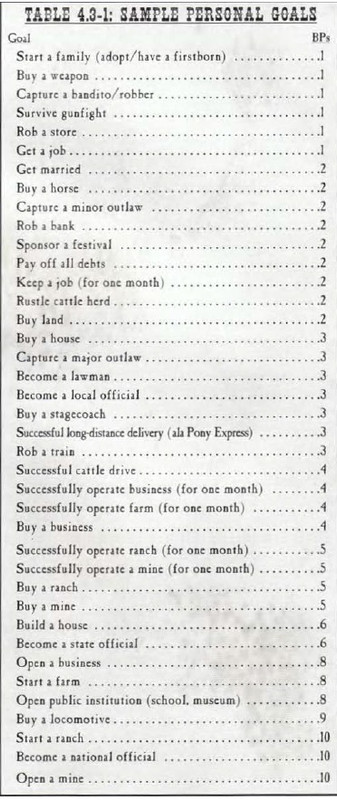
Obviously, this list is not exhaustive, as the possibilities are nearly endless. If a particular goal does not appear on the list, ask the GM.
REMARKABLE EVENTS
Unexpected events can justify additional BPs, but normally a maximum of 1 BP per Scene.
FULL LIST OF PROFESSION PATHS (The ones marked * will be detailed further down).
|
Apothecary |
Land Broker |
DETAILED PROFESSION PATHS
The following Profession Paths are the ones that fit the current storyline and most probably will be chosen at some point by a character(s). Before each Scene, the Profession Path for each character is confirmed.
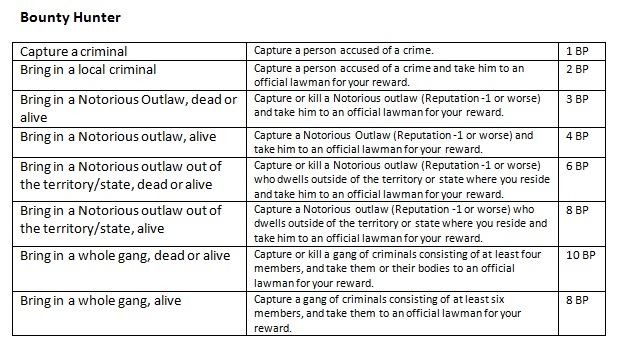
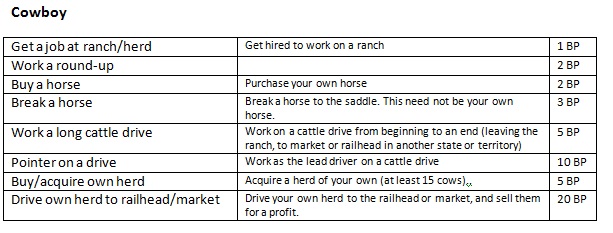
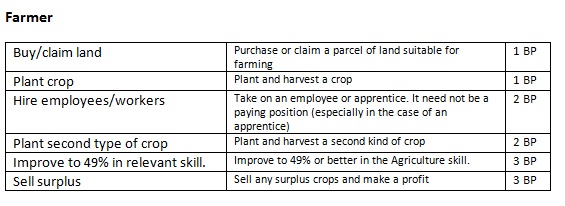
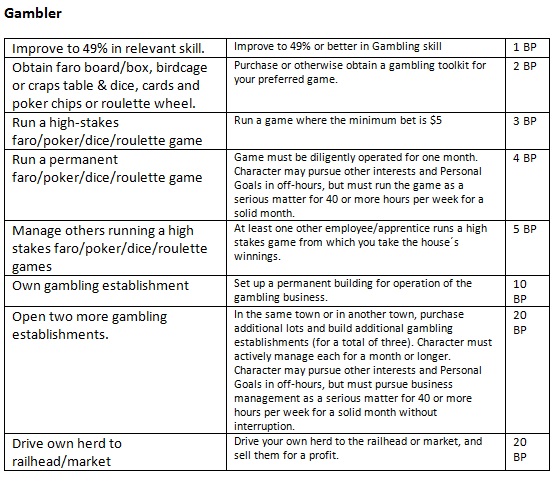
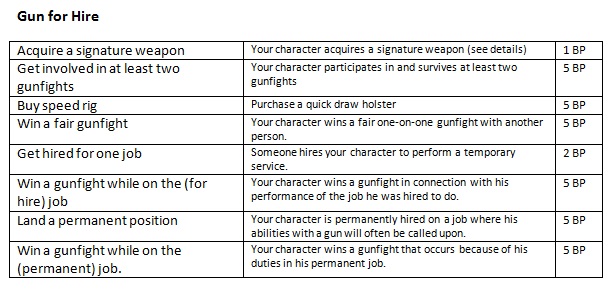
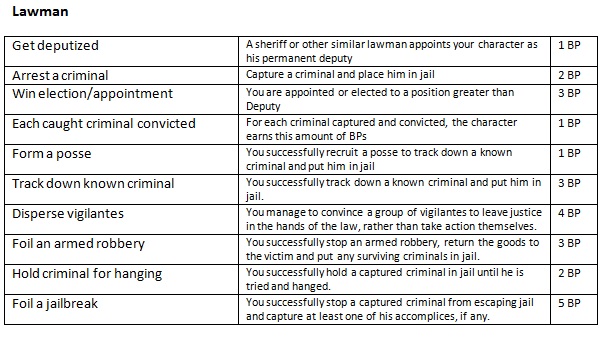
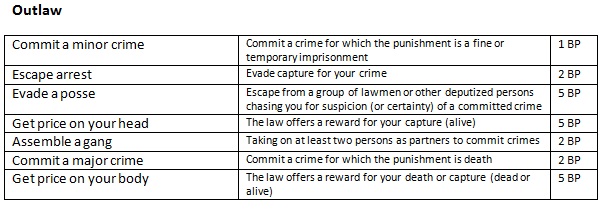
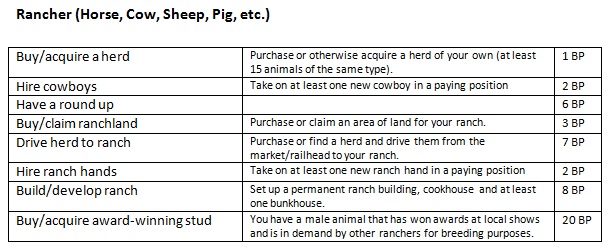
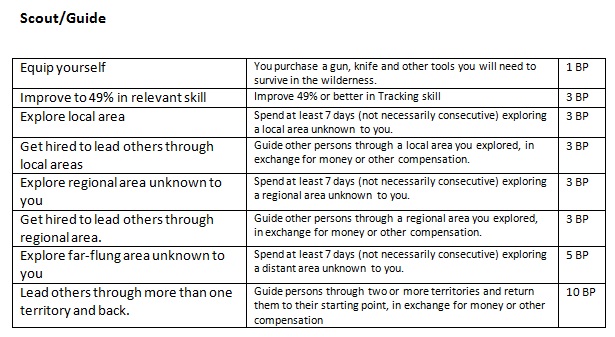
HORSES
In the West, a man´s horse is one of his most important tools. A horse is much more than just a mode of transportation. A horse can pull wagons, shield its rider from enemies, help round up stray cattle, carry a rider across a river, and be a companion in the solitary open spaces. A man´s Reputation may even rise and fall depending on the horse he rides.
Note that a horse´s height is given in “hands”. A hand equals 4 inches. The height is measured in a perpendicular line from the highest part of the back to the ground.
On the trail, each cowboy often had seven horses: two for mornings, two for the afternoons, his best two for night-work, and one to carry him to and from chapel or the saloon on Sundays. His mobility was based on the remuda system, spare horses being herded along by the horse-wrangler.
BREEDS
Horses are bred for speed and agility; strength and calmness. They come in many shapes, sizes and colors, as well as various temperaments and qualities.
Light horse breeds
Arabian (height 14-15.2 hands; weight 900-1,000 lbs): known for their endurance, sure-footedness on rough terrain and the ability to survive on a sparse diet. Most Arabians have fine features, distinctive dishes (concave) faces and silky manes and coats.
Morgan (height 14.2-15.2 hands; weight 900-1,000 lbs): a very active and versatile, with boundless stamina and a kindly nature. They are frequently used as working trail and cow horses.
Quarter Horse (height 15.2 hands; weight 950-1,100 lbs): adopted by ranchers and cowboys to use with range cattle, the Quarter Horse has a good “cow sense” for herding and cutting cattle. Most Quarter Horses are compact and attractive with massive, powerful quarters, strong shoulders, and a short, muscular back. It´s kind disposition, intelligence and great agility make it a good mound for working cattle, or as a popular all-purpose horse. They have been bred for speed, and the name is because they are particularly dominant in the first quarter mile.
Thoroughbred (height 15,1-16.2 hands; weight 900-1,200 lbs): admired for speed and endurance, this is one of the most versatile horse breeds. They are popular as cow horses, hunters and jumpers, as well as racing horses. Thoroughbreds have long smooth muscles, long forearms, long sloping shoulders and a long distance from the hip to the hock.
Mustangs
Mustangs (height 14-15 hands; weight 700-800 lbs): feral horses living in areas with scrub-type vegetation. They travel in wild herds and are favorite mounts of the Indians. A small, inelegant, lightweight horse, it possesses an intractable temperament. It is an extremely hardy horse, and its years of foraging for food made it an economical feeder. The Mustang also has “cow-sense”: it always seems to know what a cow will do next. Once broken, Mustangs are usually quiet, good-tempered mounts.
Draft horses
Percheron (stallion height 16-17 hands; weight 1,800-2,000 lbs, mare 15-16 hands and 1,500-1,600 lbs). The Percheron has better balance and is more refined than many Draft Horse breeds. Predominately black or gray, and frequently crossbred with Thoroughbreds to produce hunters and jumpers.
Shire (height 16.2-17 hands; weight 2,000 lbs): sometimes criticized for having straight shoulders and pasterns, feathers and a sluggish temperament.
Heavy Harness or Coach Horses
MARKING & COLORATION
Color is the last thing you should consider when buying a horse. However, horse´s colors and color patterns serve to identify horses.
Head markings: irregular star, snip, narrow stripe, star and connected narrow stripe, star and connected snip, bald face, chin spot.
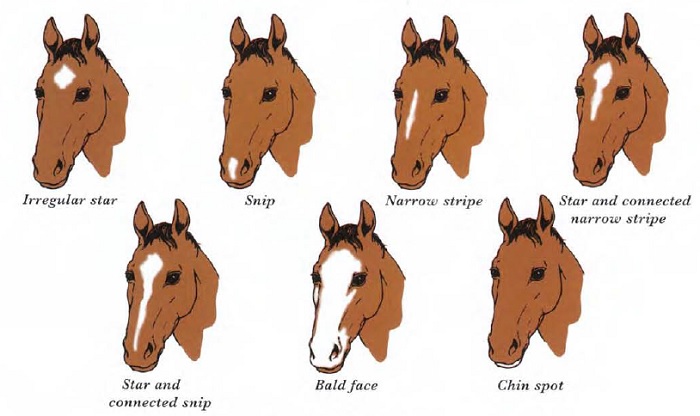
Leg markings: (from low to high): coronet, half pastern, pastern, pastern and part of ankle, ankle, white to above the ankle, half stocking, three quarters stocking, full stocking. Also heel (only), and outside of heel
COLOR
Appaloosa: variety of spotting patterns in many colors. Leopard pattern is a white coat with dark spots. Blanket pattern is a white blanket, usually containing dark spots.
Black: if the black coat color fades when exposed to the sun for several days, it is known as a “blackish bay”. A “jet black” horse´s coat does not fade.
Bay: black mane and tail, black hair below knees and hocks, black muzzle, black tips on the ears, and a reddish body.
Chestnut or sorrel: brown skin and red hairs. Lighter-colored horses are called “sorrel”, and the darker are “chestnut”.
Gray: white hairs, mingled with hairs of the base color. Colored hairs are continuously being replaced with white hairs, so that older gray horses are almost completely white.
Grulla: black mane and tail, black hair below knees and hocks, black muzzle, black tips on the ears, and sooty black hairs on the rest of the body
Dun: modification of the dark bay color and may be described as a dingy yellow.
Buckskin: modification of the light bay color, which as a light yellow body color with the black mane, tail and legs.
Paint or pinto: white spotting. Tobiano pattern is white spotting that crosses over the top of the horse´s back and downward. Overo pattern, the white extends from the belly and legs toward the back. “Piebald” is black-pigmented skin and coat color. Brown-pigmented horses are “skewbalds”. There are four different types: piebald tobianos, piebald overos, skewbald tobianos and skewbald overos
Palomino: characterized by its yellow body color, along with lighter yellow mane and tail
Roan: this coat color is characterized by white hairs mingled with hairs of the base color. However, these white hairs are present at birth and do not increase in number as the horse ages (different to grays).
White: white horses are born white and remain white throughout their lives. Two subsets of the white coat color pattern are “cremello” (cream-colored body and blue eyes) and prelino (pearl-white color).
AGE AND SEX
Young horses are referred to according to their age. A young horse is a “foal” until it is weaned at about one year old. The male horse is called a “colt” until it is a three years old, when it is called a stallion. A young female horse is a “filly” until it is three years old, at which time it becomes a “mare”. A “gelding” is a neutered stallion.
The best age to buy a horse is when it is between four and twelve years old. Before four years, the horse is not fully mature and not ready for hard work and long hours of riding.
BEHAVIOR AND TEMPERAMENT
There are six general temperament types: quiet, interested, nervous, extremely nervous, stubborn and treacherous.
VICES
Many horses have one or more bad habits. The vices come in three categories:
Aggressive vices: charging, striking, kicking, biting, bucking
Flight responses: rearing, balking, shying, halter pulling, running away
Stall vices: wood chewing, cribbing, weaving, stall walking, bolting food, pawing and tail rubbing
GAITS
A horse has five natural gaits: walk, trot, lope, gallop and back
CLOTHING & EQUIPMENT
Bit: this small bar, normally made of metal, attaches to the bridle. It is placed in the horse´s mouth so as to regulate the position of its head, and to help control its pace and direction.
Bridle: the part of a horse´s saddler or harness that fits around the head.
Clothing: a cowboy usually wears a wide-brimmed hat with a flat crown. This shelters him from the sun and rain, protects his head and face, and serves as a pillow at night. A large silk or cotton square, knotted loosely round the neck, serves as sweat-rag, bandage, water-filter, dust-mask and mosquito net. A flannel shirt with close-fitting cuffs is warm, yet less sweaty and constrictive than a jacket. In winter, a sheepskin coat might also be necessary. The cowboy´s trousers are loose, tucked into high-heeled boots. These boots can be dug into the ground to help hold a roped steer, and don´t slip through the wide wooden stirrups. Leather chaps give a good grip on the saddle, are used as a groundsheet at night, and protect legs against the friction of long distance riding, and thorns, kicks, snake-bites and rain. The spurs have huge rowels, more humane than prick-spurs, making a distinctive clink that a horse recognizes. The lariat is used for roping cattle, tying between trees to make a temporary corral, stringing up horse-thieves, and other purposes.
Hackamore: a bit-less bridle, made of a braided rawhide noseband with two leather strips, one on each side of the horse´s head, to act as cheek plates.
Halter: a hemp rope headpiece with lead rope attached. It is used for leading a horse without a bridle, or for tying up a horse in the stable.
Pad: the pad is a saddle blanket placed in between the saddle and the horse.
Reins: this pair of long narrow straps attaches to the bit or bridle. The rider uses the reins to guide and control the horse.
Saddle: the cowboy´s saddle is designed to be comfortable on a long day´s ride, to prevent inexperienced riders from causing galls (open sores) on the horse´s back, and to make it easier to sit on a difficult horse. A saddle is a cowboy´s trademark, and he takes particular pride in having the best and most elaborate saddle he can afford. Due to its size and weight, the stock saddle has two cinches, fore and aft, which hold it firmly in place. These are made of horsehair or lamp-wick so as not to cause galls on the belly.
Shoes: it is important for horses to be shod, primarily to increase traction and protect the hoof wall from excessive wear and damage.
BREAKING A HORSE
A young horse can be “forefooted” (roped around both forefeet) as he runs round the corral. This brings him down violently. While he is on the ground, he is saddled, and then mounted. If the cowboy can stay on until the horse stops bucking, it´s been “broken”.
Alternatively, the horse might be saddled and mounted when tied to a post, or held by a strong man, with a rope round the lower jaw.
There are different methods, but no matter what form of breaking is chosen, a successful Bronc Busting skill check is required.
EQUINE ATTRIBUTES
A horse sheet is given for each character horse. Horse statistics are rolled (3d6) and modified by breed:
Short Speed: ¼ mile
Medium Speed: 1 mile
Long Speed: 5 mile
Agility: ability to turn on a dime, jumping, surefootedness over rocky terrain
Endurance: speed over long distances, can survive on little food or water, perform in adverse weather, etc.
Horse Sense: ranges from “runs into walls” to “smart as a dog”
Temperament: ranges from “ornery” to “loveable”
Trainability: ranges from “barely trainable” to “easily trained”
Mettle: ranges from “easily spooked” to “steadfast” (even if whipped)
Soundness: ranges from “sickly/weak” to “never gets sick/hurt”
Strength: ability to pull or carry heavy loads
SKILL ADVANCEMENT
Please check the Skill List table above. The BP cost for each skill is listed there. You spend earned BPs to “purchase” improvement on the skills. This base BP cost is modified by the attribute (see below).
Each purchase improves the skill by the attribute + Mastery Die (Universal Skills already get the twice the attribute value on the first purchase). If the Relevant Ability Score lists more than one skill, the lowest value is used.
Skill Mastery Die determines how much the skill is increased. For instance, Accounting skill is 1d8 (plus the Relevant Ability Score)
The BP cost for each skill is modified by the Skill Learning Modifier. This comes from high Intelligence, Wisdom and/or Charisma. If the skill uses one of those three attributes, it can be purchased with a lower cost (or higher).
| ATTRIBUTE VALUE | LEARNING MODIFIER |
| ... | ...-1 |
| 8 | -2 |
| 9 | -1 |
| 10-11 | 0 |
| 12 | 1 |
| 13 | 2 |
| ... | ...+1 |


